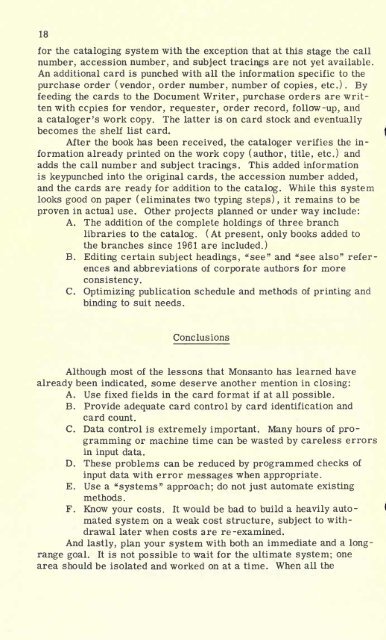Proceedings of the 1964 Clinic on Library Applications of ... - ideals
Proceedings of the 1964 Clinic on Library Applications of ... - ideals
Proceedings of the 1964 Clinic on Library Applications of ... - ideals
Create successful ePaper yourself
Turn your PDF publications into a flip-book with our unique Google optimized e-Paper software.
18<br />
for <str<strong>on</strong>g>the</str<strong>on</strong>g> cataloging system with <str<strong>on</strong>g>the</str<strong>on</strong>g> excepti<strong>on</strong> that at this stage <str<strong>on</strong>g>the</str<strong>on</strong>g> call<br />
number, accessi<strong>on</strong> number, and subject tracings are not yet available.<br />
An additi<strong>on</strong>al card is punched with all <str<strong>on</strong>g>the</str<strong>on</strong>g> informati<strong>on</strong> specific to <str<strong>on</strong>g>the</str<strong>on</strong>g><br />
purchase order (vendor, order number, number <str<strong>on</strong>g>of</str<strong>on</strong>g> copies, etc.) .<br />
By<br />
feeding <str<strong>on</strong>g>the</str<strong>on</strong>g> cards to <str<strong>on</strong>g>the</str<strong>on</strong>g> Document Writer, purchase orders are written<br />
with copies for vendor, requester, order record, follow-up, and<br />
a cataloger's work copy. The latter is <strong>on</strong> card stock and eventually<br />
becomes <str<strong>on</strong>g>the</str<strong>on</strong>g> shelf list card.<br />
After <str<strong>on</strong>g>the</str<strong>on</strong>g> book has been received, <str<strong>on</strong>g>the</str<strong>on</strong>g> cataloger verifies <str<strong>on</strong>g>the</str<strong>on</strong>g> informati<strong>on</strong><br />
already printed <strong>on</strong> <str<strong>on</strong>g>the</str<strong>on</strong>g> work copy (author, title, etc.) and<br />
adds <str<strong>on</strong>g>the</str<strong>on</strong>g> call number and subject tracings. This added informati<strong>on</strong><br />
is keypunched into <str<strong>on</strong>g>the</str<strong>on</strong>g> original cards, <str<strong>on</strong>g>the</str<strong>on</strong>g> accessi<strong>on</strong> number added,<br />
and <str<strong>on</strong>g>the</str<strong>on</strong>g> cards are ready for additi<strong>on</strong> to <str<strong>on</strong>g>the</str<strong>on</strong>g> catalog. While this system<br />
looks good <strong>on</strong> paper (eliminates two typing steps), it remains to be<br />
proven in actual use. O<str<strong>on</strong>g>the</str<strong>on</strong>g>r projects planned or under way include:<br />
A. The additi<strong>on</strong> <str<strong>on</strong>g>of</str<strong>on</strong>g> <str<strong>on</strong>g>the</str<strong>on</strong>g> complete holdings <str<strong>on</strong>g>of</str<strong>on</strong>g> three branch<br />
libraries to <str<strong>on</strong>g>the</str<strong>on</strong>g> catalog. (At present, <strong>on</strong>ly books added to<br />
<str<strong>on</strong>g>the</str<strong>on</strong>g> branches since 1961 are included.)<br />
B. Editing certain subject headings, "see" and "see also" references<br />
and abbreviati<strong>on</strong>s <str<strong>on</strong>g>of</str<strong>on</strong>g> corporate authors for more<br />
c<strong>on</strong>sistency.<br />
C. Optimizing publicati<strong>on</strong> schedule and methods <str<strong>on</strong>g>of</str<strong>on</strong>g> printing and<br />
binding to suit needs.<br />
C<strong>on</strong>clusi<strong>on</strong>s<br />
Although most <str<strong>on</strong>g>of</str<strong>on</strong>g> <str<strong>on</strong>g>the</str<strong>on</strong>g> less<strong>on</strong>s that M<strong>on</strong>santo has learned have<br />
already been indicated, some deserve ano<str<strong>on</strong>g>the</str<strong>on</strong>g>r menti<strong>on</strong> in closing:<br />
A. Use fixed fields in <str<strong>on</strong>g>the</str<strong>on</strong>g> card format if at all possible.<br />
B. Provide adequate card c<strong>on</strong>trol by card identificati<strong>on</strong> and<br />
card count.<br />
C. Data c<strong>on</strong>trol is extremely important. Many hours <str<strong>on</strong>g>of</str<strong>on</strong>g> programming<br />
or machine time can be wasted by careless errors<br />
in input data.<br />
D. These problems can be reduced by programmed checks <str<strong>on</strong>g>of</str<strong>on</strong>g><br />
input data with error messages when appropriate.<br />
E. Use a "systems" approach; do not just automate existing<br />
methods.<br />
F. Know your costs. It would be bad to build a heavily automated<br />
system <strong>on</strong> a weak cost structure, subject to withdrawal<br />
later when costs are re-examined.<br />
And lastly, plan your system with both an immediate and a l<strong>on</strong>grange<br />
goal. It is not possible to wait for <str<strong>on</strong>g>the</str<strong>on</strong>g> ultimate system; <strong>on</strong>e<br />
area should be isolated and worked <strong>on</strong> at a time. When all <str<strong>on</strong>g>the</str<strong>on</strong>g>
















